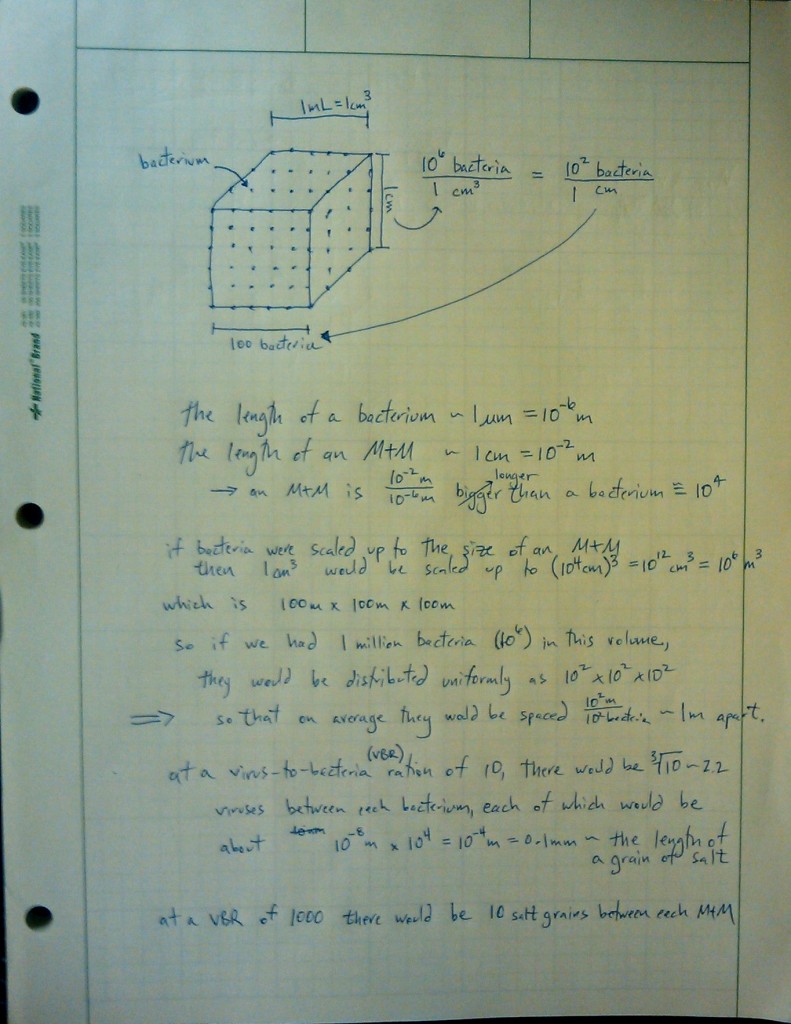There are about 1,000,000 bacteria per milliliter (1/5 of a teaspoon) of water in the coastal ocean. (!!) A lot of these bacteria degrade dead plant and algae material and turn them into useful nutrients which can allow further growth of plants and algae and animals. Without bacteria in the oceans to regenerate these nutrients, life there would be (nearly) impossible!
Bacteria are small. Very small. The length of a bacterium is about 1/1,000,000 of a meter (one meter is 3.3 feet). One milliliter of water has the same volume as one cubic centimeter (cc) of water, which, being a cube, has three characteristic dimensions, or sides: length, width, and height. The length of each of those sides is 1 centimeter (cm, 1/100 of a meter, or about 3/8 of an inch). If the 1,000,000 bacteria in that one cubic centimeter of ocean water were spread out evenly, they would also make a cube. Each side of the cube would have 100 bacteria because 100 x 100 x 100 = 1,000,000. The distance between each bacterium on that side would then be 1 cm/100 bacterium = 0.01 cm between each bacterium.
Now let’s scale up the whole thing so that we can actually see it. Let’s make a bacterium the same length as a raisin (about 1 cm), which is an increase by a factor of 10,000. In that case the distance between each bacterium (raisin) would be 0.01 cm * 10,000 = 100 cm = 1 meter. So each bacterium would be about one meter from any other bacterium in any direction.
There are also a lot of viruses in ocean water that can infect the bacteria — about 10x more than there are bacteria, and each virus is about 1/100 as long as a bacterium. So scaled up, a virus would be about 1 cm/100 = 0.01 cm = 0.1 mm long, which is a bit smaller than a grain of table salt. Divided into all three directions, there would be 10^(1/3) ~ 2.2 viruses (salt grains) on the line between each bacterium.
Remember that these bacteria and viruses are not there to hurt you! They act like nature’s recycling bin, taking in waste products and returning useful nutrients to the environment. We should thank them every day for keeping things running smoothly!
Thanks for reading!
Eric
Tags: bacteria · outreach · science4 Comments




4 responses so far ↓
Hi. I was wondering if you have a reference for the 1,000,000 bacteria in coastal water figure. I can’t find a decent book reference for this.
Hi Tom,
Check out an oldie but goody:
Maranger & Bird (1995) Viral abundance in aquatic systems: a comparison between marine and fresh waters. Marine Ecology Progress Series 121:217-226.
I should note that “about 1,000,000” is “about” a million on a log scale — there is a lot of variation but most measurements fall between 100,000 and 10,000,000.
really?! I thought it was less, and no ones doing anything about it?!
Let’s take a brief look at what would happen if all the bacteria in the oceans died off:
1) Oil spills would linger for thousands of years with no bacteria to break the oil down.
2) Cyanobacteria, which produce perhaps 40% of the Earth’s atmospheric oxygen, would die out, leaving us gasping for breath at an oxygen concentration comparable to living at an altitude of 10,000 feet.
3) Meanwhile, dead plants and animals would accumulate and sink to the ocean floors, burying huge amounts of carbon that would otherwise be broken down into CO2 (carbon dioxide). This drawdown of carbon would cause an ice age because CO2 warms the atmosphere by the greenhouse effect.
4) But before that could happen, ammonia (toilet bowl cleaner) would build up in the oceans to toxic levels because the bacteria that normally recycle the ammonia would be gone. Ocean plants that require nitrate (recycled ammonia) would die out and so would the animals that feed on them. The oceans as we know them would die.
If you like our oceans to be clean and healthy — thank a bacterium today!